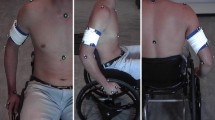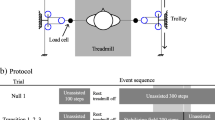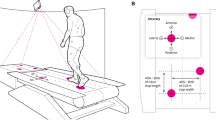Abstract
Many individuals, such as persons with spinal cord injury (SCI), rely on wheeled locomotion involving manual (MWC) or power (PWC) wheelchairs to navigate their environments. Yet, visuo-locomotor control underlying WC navigation in experienced users is not well understood. The objective of this study was to compare the visuo-locomotor control between MWC and PWC in individuals with SCI while changing direction and circumventing an obstacle. Participants with SCI using a MWC (n = 12, 38.5 ± 10.7 years) or a PWC (n = 10, 47.8 ± 8.6 years) were asked to maneuver their chair straight ahead, while changing direction 45° to the right, and while circumventing an obstacle to the right, all at self-selected speeds. Speed, minimal clearance, point of deviation, temporal body and WC coordination, relative timing of segment rotations and visual behavior were analyzed. There was no main effect of group for speed, clearance and point of deviation. During direction change, the head always led body and wheelchair reorientation while an “en bloc” strategy was used for circumventing obstacle for both groups. In straight-ahead locomotion, participants predominantly fixed their gaze on the end target. During direction change and obstacle circumvention, participants fixated more on the future path and the obstacle for both WC modes. Overall, specific gaze behavior depended on environmental demands. While MWC and PWC users adopt similar navigational strategies and visuo-locomotor coordination while changing direction and circumventing obstacle, there were some differences in the amount of head rotation that could be related to a counter-movement used more by PWC users.



Similar content being viewed by others
References
Bernardin D, Kadone H, Bennequin D, Sugar T, Zaoui M, Berthoz A (2012) Gaze anticipation during human locomotion. Exp Brain Res 223:65–78. doi:10.1007/s00221-012-3241-2
Blouin M, Lalumiere M, Gagnon DH, Chenier F, Aissaoui R (2015) Characterization of the immediate effect of a training session on a manual wheelchair simulator with haptic biofeedback: towards more effective propulsion. IEEE Trans Neural Syst Rehabil Eng 23:104–115. doi:10.1109/TNSRE.2014.2330837
Brault MW (2012) American with disabilities: 2010. US Department of Commerce, Economics and Statistics Administration. US Census Bureau
Charette C, Routhier F, McFadyen BJ (2015) Visuo-locomotor coordination for direction changes in a manual wheelchair as compared to biped locomotion in healthy subjects. Neurosci Lett 588:83–87. doi:10.1016/j.neulet.2015.01.002
Colby SL, Ortman JM (2015) Projections of the size and composition of the US population: 2014 to 2060. US Department of Commerce, Economics and Statistics Administration. US Census Bureau
Gagnon DH, Babineau AC, Champagne A, Desroches G, Aissaoui R (2014) Pushrim biomechanical changes with progressive increases in slope during motorized treadmill manual wheelchair propulsion in individuals with spinal cord injury. J Rehabil Res Dev 51:789–802. doi:10.1682/JRRD.2013.07.0168
Gerin-Lajoie M, Richards CL, McFadyen BJ (2005) The negotiation of stationary and moving obstructions during walking: anticipatory locomotor adaptations and preservation of personal space. Motor Control 9:242–269
Grasso R, Glasauer S, Takei Y, Berthoz A (1996) The predictive brain: anticipatory control of head direction for the steering of locomotion. Neuroreport 7:1170–1174
Grasso R, Prévost P, Ivanenko YP, Berthoz A (1998) Eye-head coordination for the steering of locomotion in humans: an anticipatory synergy. Neurosci Lett 253:115–118
Hicheur H, Vieilledent S, Berthoz A (2005) Head motion in humans alternating between straight and curved walking path: combination of stabilizing and anticipatory orienting mechanisms. Neurosci Lett 383:87–92. doi:10.1016/j.neulet.2005.03.046
Higuchi T (2013) Visuomotor control of human adaptive locomotion: understanding the anticipatory nature. Front Psychol 4:277. doi:10.3389/fpsyg.2013.00277
Higuchi T, Cinelli ME, Patla AE (2009a) Gaze behavior during locomotion through apertures: the effect of locomotion forms. Hum Mov Sci 28:760–771. doi:10.1016/j.humov.2009.07.012
Higuchi T, Hatano N, Soma K, Imanaka K (2009b) Perception of spatial requirements for wheelchair locomotion in experienced users with Tetraplegia. J Physiol Anthropol 28:15–21. doi:10.2114/jpa2.28.15
Hollands M, Sorensen K, Patla A (2001) Effects of head immobilization on the coordination and control of head and body reorientation and translation during steering. Exp Brain Res 140:223–233. doi:10.1007/s002210100811
Hollands M, Patla A, Vickers J (2002) “Look where you’re going!”: gaze behaviour associated with maintaining and changing the direction of locomotion. Exp Brain Res 143:221–230. doi:10.1007/s00221-001-0983-7
Hwang S, Lin Y-S, Hogaboom NS, Wang L-H, Koontz AM (2016) Relationship between linear velocity and tangential push force while turning to change the direction of the manual wheelchair. Biomed Eng (Biomed Tech). doi:10.1515/bmt-2015-0173
Imai T, Moore ST, Raphan T, Cohen B (2001) Interaction of the body, head, and eyes during walking and turning. Exp Brain Res 136:1–18. doi:10.1007/s002210000533
Kirby R (2011) The Wheelchair Skills Program. http://www.wheelchairskillsprogram.ca. Accessed 30 April 2017
Kirby R et al (2015) Effectiveness of a wheelchair skills training program for powered wheelchair users: a randomized controlled trial. Arch Phys Med Rehabil 96:2017–2026. doi:10.1016/j.apmr.2015.07.009
Lalumiere M, Gagnon DH, Routhier F, Bouyer L, Desroches G (2014) Upper extremity kinematics and kinetics during the performance of a stationary wheelie in manual wheelchair users with a spinal cord injury. J Appl Biomech 30:574–580. doi:10.1123/jab.2013-0333
Mars F (2008) Driving around bends with manipulated eye-steering coordination. J Vis 8(11):10.1–10.11. doi:10.1167/8.11.10
National Spinal Cord Injury Statistical center (2015) Annual statistical report for the spinal cord injury model systems public version. University of Alabama at Birmingham: Birmingham, Alabama. https://www.nscisc.uab.edu/reports.aspx Accessed December 2015
Noonan VK, Fingas M, Farry A, Baxter D, Singh A, Fehlings MG, Dvorak MF (2012) Incidence and prevalence of spinal cord injury in Canada: a national perspective. Neuroepidemiology 38:219–226. doi:10.1159/000336014
Paquette MR, Vallis LA (2010) Age-related kinematic changes in late visual-cueing during obstacle circumvention. Exp Brain Res 203:563–574. doi:10.1007/s00221-010-2263-x
Patla A, Adkin A, Ballard T (1999) Online steering: coordination and control of body center of mass, head and body reorientation. Exp Brain Res 129:629–634
Pradeep Ambati VN, Murray NG, Saucedo F, Powell DW, Reed-Jones RJ (2013) Constraining eye movement when redirecting walking trajectories alters turning control in healthy young adults. Exp Brain Res 226:549–556. doi:10.1007/s00221-013-3466-8
Routhier F, Kirby RL, Demers L, Depa M, Thompson K (2012) Efficacy and retention of the French-Canadian version of the wheelchair skills training program for manual wheelchair users: a randomized controlled trial. Arch Phys Med Rehabil 93:940–948. doi:10.1016/j.apmr.2012.01.017
Smith EM, Giesbrecht EM, Mortenson WB, Miller WC (2016) Prevalence of wheelchair and scooter use among community-dwelling Canadians. Phys Ther 96:1135–1142. doi:10.2522/ptj.20150574
Statistics Canada (2015) Population projections for Canada (2013 to 2063), Provinces and Territories (2013 to 2038). Minister of Industry. http://www.statcan.gc.ca/pub/91-520-x/91-520-x2014001-eng.pdf. Accessed 30 Apr 2017
Torkia C, Reid D, Korner-Bitensky N, Kairy D, Rushton PW, Demers L, Archambault PS (2015) Power wheelchair driving challenges in the community: a users’ perspective. Disabil Rehabil Assist Technol 10:211–215. doi:10.3109/17483107.2014.898159
Vallis LA, McFadyen BJ (2003) Locomotor adjustments for circumvention of an obstacle in the travel path. Exp Brain Res 152:409–414. doi:10.1007/s00221-003-1558-6
Acknowledgements
The authors would like to thank Mr. Guy St-Vincent and Mr. Olivier Doyle for their technical assistance and Mr. Jean Leblond for statistical consulting. This study was supported in part by the National Sciences and Engineering Research Council of Canada (Grant No: 191782-2012) (B.J. McFadyen; bursary to C. Charette) and by the Fonds de recherche du Québec-Santé (bursary to C. Charette and research scholar Junior 1 to F. Routhier).
Author information
Authors and Affiliations
Corresponding author
Ethics declarations
Conflict of interest
The authors declare that they have no conflict of interest.
Rights and permissions
About this article
Cite this article
Charette, C., Routhier, F. & McFadyen, B.J. Visuo-locomotor control in persons with spinal cord injury in a manual or power wheelchair for direction change and obstacle circumvention. Exp Brain Res 235, 2669–2678 (2017). https://doi.org/10.1007/s00221-017-4994-4
Received:
Accepted:
Published:
Issue Date:
DOI: https://doi.org/10.1007/s00221-017-4994-4




